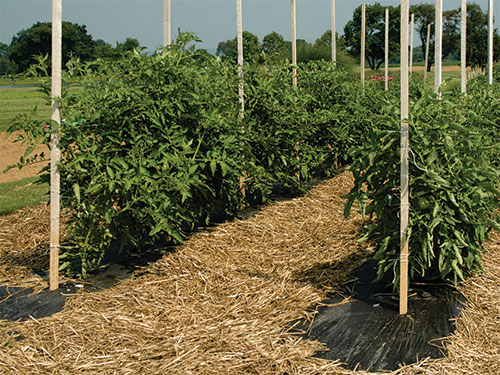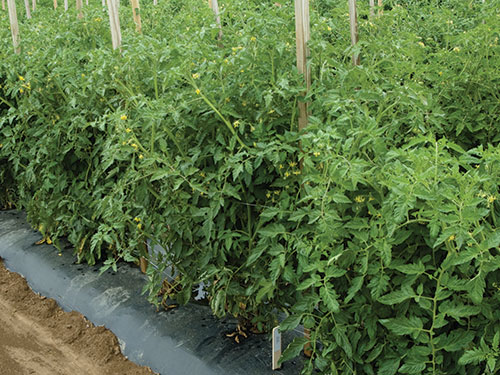
Fact Sheet FS1102
The Stake and Weave System
Staking and weaving is a highly specialized production system used by commercial tomato growers. It is a system that can easily be adapted for home garden use. Some advantages of staking are improved fruit quality and yield, ease of harvest, less disease, improved spray coverage, larger fruit, and fewer damaged fruit or fruit with imperfections.
This system utilizes wooden stakes four to eight feet long by approximately 1 inch square, and twine woven around the stakes to train plants to a more upright growth habit, keeping foliage and fruit off the ground to prevent diseases. Some pruning of suckers (shoots) near the base of the plant is usually practiced; how much depends on the variety grown. A raised bed with plastic mulch and drip irrigation are also common in this system and are highly recommended for commercial farm production, but are not necessary in the home garden.
Tomato Variety Selection
Compact (determinate) varieties are most manageable with this system but any variety can be staked and weaved. With vigorous tall (indeterminate) varieties such as heirlooms, six or eight foot stakes should be used. See Rutgers Fact Sheet FS678 Growing Tomatoes in the Home Garden for suggested varieties and cultural information.
Stakes
Stakes must be strong enough to hold plants off the ground and have a non-slip surface to "grab" the twine. Two types of stakes that fit these conditions are metal reinforcing bars and pine stakes. Wooden stakes that are treated to resist decay can be reused, usually for three to four growing seasons. Untreated stakes may last only one season. When reusing stakes it is a good practice to disinfect the stakes by submerging them in a 5% bleach (hypochlorite) solution (½ cup of household bleach with two cups of water) for 20 minutes to reduce the chance of carrying over diseases from the previous year.
Plant Spacing
Row width should provide easy access for equipment and gardeners. In the home garden, four to five feet is usually adequate. In row plant spacing of 18 to 21 inches is recommended for sandy lighter soils and for varieties that have a compact plant habit; 21 to 24 inches is recommended for heavier clay or loam soils and for varieties that have a vigorous plant habit.
Twine
Suitable twine must resist weathering (look for UV [ultraviolet] resistant twine) and stretching, and bind well to the stakes. Commercial growers typically use synthetic twine due to its strength and because it does not break down as rapidly as natural jute twine. Nylon "baler's" string is a good choice. Jute "binder's" twine may stretch.
Pruning
Pruning is practiced to establish a desired balance between vine growth and fruit growth. Pruning results in larger fruit, improves pest control due to improved air circulation and spray coverage, and increases tying and harvesting efficiency compared to little to no pruning. Pruning can result in earlier maturity of the first fruit and higher early yield.
Axillary shoots, or suckers, are the part of the plant that can be removed by pruning (see Figure 1A). Removing all suckers from the ground up to the one immediately below the first flower cluster on the main stem has been the recommended practice. This is sometimes referred to as pruning to the "fork" (see Figure 1B). Removing the sucker immediately below the first flower cluster on the main stem or pruning above this flower cluster can result in severe leaf curling and stunting of the plant and therefore should be avoided. A single pruning when the suckers are two to four inches long is usually adequate. In some years, however, a second pruning is required to remove suckers that were too small to be removed easily during the first pruning. Also, a second pruning may be required to remove ground suckers (suckers that are at the plant, near the soil surface) that may develop. Pruning when suckers are too large requires more time and can damage the plants, causing possible delays in maturity and increased disease incidence. Using a twisting motion to remove the sucker rather than pulling downward on suckers can minimize damage when pruning. Pruning plants when they are wet can spread bacterial diseases and therefore should be avoided. Plants should be pruned, if possible, before the first stringing, because the string can get in the way, slowing down the pruning process. Pruning is variety dependent, the less vigorous varieties generally requiring less pruning (see Figure 1C). This is particularly true for late plantings that may experience more stress due to hot growing conditions.
Staking
Stakes are driven approximately 12 inches into the soil between the plants. A stake placed between every other plant is usually adequate to support most varieties (see Figure 2). Vigorous varieties may require larger and longer stakes. Placing an additional stake at a right or 90 degree angle and tied to the end stake of each row can be helpful in ensuring a strong trellis system. Alternatively, using two stakes placed together at the ends of a row can work to reinforce the trellis. Stakes can be driven by hand with a homemade driving tool (a 36 inch length of heavy pipe capped at the end or similar tool should be adequate) or with a small sledgehammer or mallet.
To make tying convenient, a homemade stringing tool should be used. This tool can be made from a length of metal conduit, PVC pipe, broom handle, wooden dowel, or wooden stake. With conduit or PVC pipe, the string is fed through the pipe. With a broom handle, wooden dowel, or wooden stake, two small parallel holes, each approximately ½ to 1 inch from the end, must be drilled to feed the string through one hole along the length of the tool, and through the other hole. The tool, which can be cut to any length the gardener prefers, serves as an extension of the arm and helps to keep the string tight. Proper stringing consists of tying the twine to an end stake, passing the string along one side of the plants, and looping the twine around each stake. When you reach the end of a row continue the same process on the other side of the row. The string must be kept very tight throughout the stringing process. The string tension must be tight enough to hold the plants upright and well trained, but if the string is too tight harvest can be difficult, and string scars or misshapen fruit may result. The first stringing should be done before the plants fall over usually about eight to ten inches above the ground on plants 12 to 15 inches tall (see Figure 3).
This string should be approximately two inches below the first blossom cluster. Subsequent stringings, usually six to eight inches above the preceding string, are conducted before the plants start to fall over (see Figure 4). Four strings are usually required for most semi-determinate varieties. Sometimes, the first string consists of a figure eight between the two plants inside the stakes to prevent the plants from falling into each other. This is done by tying the string to the end stake and passing the string on the near side of the first plant, the far side of the second plant, and around the next stake. This process is continued to the end of the row and repeated on the return trip down the other side of the row. Stringing should be done when the foliage is dry to prevent the spread of bacterial diseases.
Figure 4. Second stringing: Approximately six to eight inches above the first string. Note the homemade stringing tool.
Adapted from: “Commercial Stake Tomato Production in New Jersey,” prepared by Philip E. Neary, former County Agricultural Agent, Gloucester County. Contributors: Stephen Reiners, former Vegetable Specialist, Rutgers Cooperative Extension; Joseph Steinke, former Horticulturist, NJ Agricultural Experiment Station, Stephen A. Garrison, former Vegetable Specialist, Rutgers Cooperative Extension. Special thanks to Carol L. Sinclair for her preparation of the diagrams.
August 2009
Copyright © 2024 Rutgers, The State University of New Jersey. All rights reserved.
For more information: njaes.rutgers.edu.
Cooperating Agencies: Rutgers, The State University of New Jersey, U.S. Department of Agriculture, and Boards of County Commissioners. Rutgers Cooperative Extension, a unit of the Rutgers New Jersey Agricultural Experiment Station, is an equal opportunity program provider and employer.



